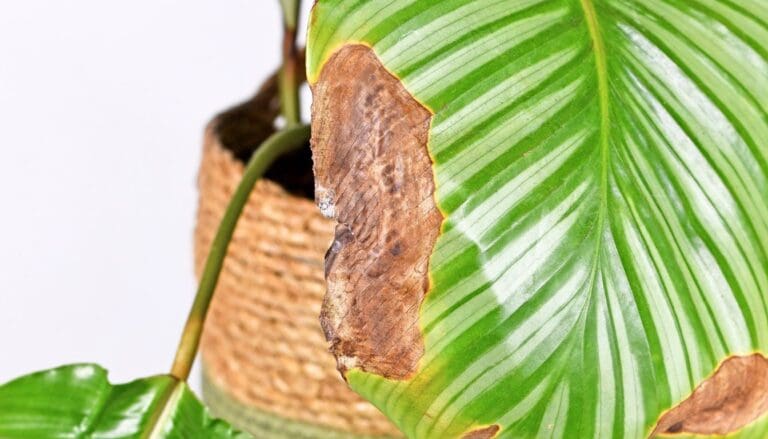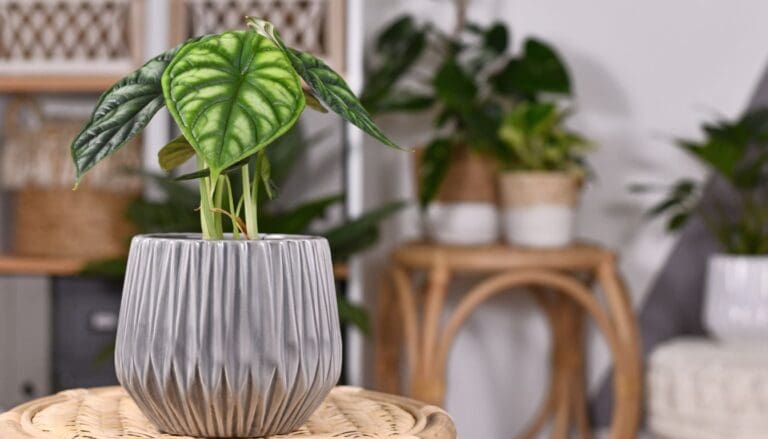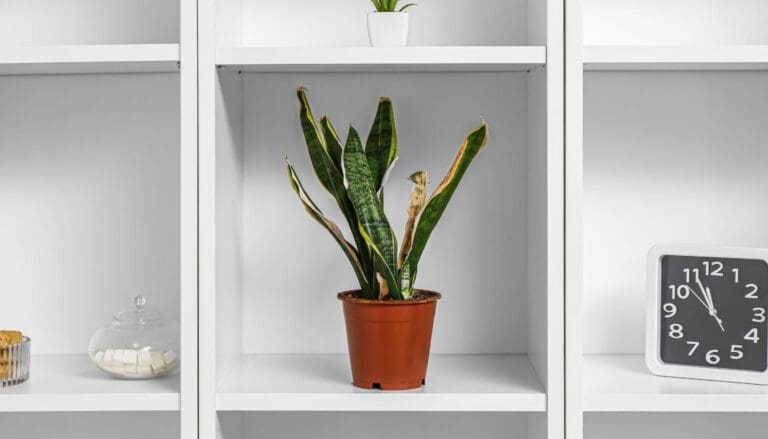Where To Place Alocasia Plant? (Ideal Placement+Factors)
Alocasia or Elephant’s ears are tropical plants that have been introduced as houseplants because of their stunning large green leaves. If you have an Alocasia at your place and want to keep it healthy, you must know where to place it.
Alocasia plants require bright indirect sunlight, high humidity, and a warm environment to thrive. Choosing a spot where it gets all these ideal conditions will keep the plant happy. Also, ensure that your children and pets can’t reach the Alocasia as it is toxic for them.
Without the proper conditions, the plant will neither grow well nor remain healthy.
In this article, I will explain all the factors you need to consider while finding a suitable spot where you can place your Alocasia, so keep reading.

Please note: Simplify Plants is reader-supported. Some links in the post are affiliate links and I get a commission from purchases made through links in the post.
Factors determining the placement of Alocasia
Let’s understand the factors that play important roles in deciding the correct placement of your Alocasia.
Light
Light is one of the most important factors that decide whether your Alocasia will thrive or not.
Light is important for all plants as they generate food and energy by using the light they receive.
Your Alocasia can thrive and proliferate with the right and sufficient lighting conditions.
Alocasia comes from the tropical regions of Asia and Australia, where they grow on forest beds under the shade of tall trees.
Therefore, they don’t get direct sunlight.
So, to mimic the lighting condition of Alocasia’s native land, you must find a spot with indirect light.
Exposing the plant to direct sunlight is a bad idea as it will scorch the leaves and dehydrate the plant.
And keeping your Alocasia in a low light spot will restrict growth and cause other problems as well.
Therefore, a spot with dappled sunlight is best for your Alocasia.
Some examples of spots where your Alocasia will get indirect sunlight:
- 6-7 feet away from the window
- A window with blinds or curtains
- Under artifical lights if your house doesn’t get enough natural light.
- A spot under a tall tree, if you are thinking of placing your Alocasia outside.
Also read: What Kind Of Light Does Alocasia Need? Alocasia Light Requirements
Temperature
Another important factor that can make or break your Alocasia is the temperature.
Every plant has a temperature range suitable for them, and for Alocasia, it ranges between 65–85°F.
These temperatures indicate that your Alocasia thrives in a warm environment.
Many people don’t know the temperatures of their houses, but measuring the temperature will help you understand if your Alocasia is getting what it needs.
You can use a thermometer or a Hygrometer to measure the temperature around your Alocasia.
If the temperatures fall in the range of Alocasia’s preference, you can rest assured that the placement is correct.
But, if the temperatures are lower or higher than what the plant needs, you need to relocate it to a different spot.
You must avoid some locations as these can harm your Alocasia by altering the temperatures.
- Don’t place your Alocasia near windows and doors that are opened and closed frequently.
- Don’t place the Alocasia too close to heating sources such as furnaces, fireplaces, vents, radiators, etc. You can place the plant in a room with a heating source but maintain a distance.
- Keep your Alocasia away from low temperatures and frost during winter.
Humidity

Humidity is an important factor determining the growth of tropical plants such as Alocasia.
Alocasia requires high humidity levels, and if you want it to thrive, you must not keep it in a spot where it gets below 50-60% humidity.
If you place your Alocasia in a low humidity spot, you will notice stunted growth, discolored leaves, and a weak plant.
A Hygrometer will tell you the exact humidity of any spot so you can use it to understand if your Alocasia is getting enough humidity.
If you have a humidifier, you can place your Alocasia near it or vice versa.
This will take care of the humidity requirements of the plant.
You can place your Alocasia in a bathroom, basement, or kitchen after ensuring all the other conditions are suitable for the plant.
These rooms provide more humidity than other rooms of the house.
If you want to protect your Alocasia from low humidity:
- Avoid exposing the plant to cold or hot drafts.
- Don’t place it opposite to the direct air of the AC.
Also read: Should I Mist My Alocasia? (Ideal Humidity+How To Maintain)
Things to consider while placing an Alocasia at home
Let’s take a look at some common spots for your Alocasia.
Alocasia near a window

A spot close to the window is ideal for all plants.
However, how close you place the plant to the window depends on the kind of light the plant needs.
Since Alocasia needs indirect light, you must check the sun’s intensity before placing the plant.
Bring your hand between the plant and the window.
If the heat feels intense and the shadow is clear, your Alocasia is getting direct sunlight, and you should consider placing it a few feet back.
But while checking the sunlight, if the heat feels less intense and the shadow is soft, your Alocasia receives indirect sunlight, perfect for the plant.
You can put on blinds or curtains to filter the direct sunlight, so your plant receives indirect light only.
Therefore, you can follow any of these to find the correct spot for your Alocasia.
Place the plant 6-10 feet away from the window, especially a South-facing window.
Put on curtains to filter the direct sunlight so your plant can receive the ideal indirect light.
During winter, you might feel the urge to place your Alocasia close to the window as the sunlight gets less intense.
But, placing the plant too close to the window can expose it to low temperatures, cold drafts, and frost.
Therefore, don’t take your Alocasia too close to the window, even during the winter months.
Alocasia in the bedroom

Alocasia is an exotic tropical plant, so placing it in your bedroom will make the space look brighter.
Another good thing about keeping the Alocasia in the bedroom is that this species purifies the air.
Alocasia removes harmful elements like formaldehyde from the air and makes it better for breathing.
However, there are some things that you should keep in mind before bringing your Alocasia into the bedroom.
- Make sure that your plant receives enough sunlight in the bedroom. The plant needs at least 6-8 hours of indirect light to survive. You can also take the help of artificial lights.
- Avoid placing your Alocasia opposite to the AC as the direct air can reduce the humidity around it.
- A bedroom with a window would be perfect as you can place the Alocasia near the window.
- Rotate the plant from time to time, so it gets light on all sides and has an even growth.
Alocasia in a bathroom
Many people like to decorate their bathrooms with plants.
This is a good idea for humidity-loving plants as a bathroom usually has more humidity than other rooms.
Since Alocasia purifies the air, placing it in the bathroom will be beneficial to filter out the harmful toxins of the cleaning products.
But before you take the plant into the bathroom, make sure there is a light source that provides 6-8 hours of indirect light to the plant.
You must also avoid splashing water on the leaves of your Alocasia, so there is no chance of bacterial or fungal growth.
Avoid placing Alocasia too close to a fireplace

Alocasia prefers warm temperatures, so people might prefer keeping the plant near a fireplace, especially during winter when the temperatures drop.
However, that will not be wise as the temperature rises higher than the plant’s preference, and the heat will dehydrate the plant and burn the leaves.
Therefore, placing your Alocasia near the fireplace is a bad idea.
But you can still make use of the fireplace and keep the plant at a distance from it.
This will ensure that your plant gets enough warmth without suffering any losses.
Place your Alocasia away from children
Alocasia is extremely toxic for children and humans.
Alocasia contains toxic calcium oxalate crystals that can cause skin irritation.
Children have more sensitive skin, so they will experience severe irritation or other issues if the sap of the Alocasia plant comes in contact with their skin.
Consumption of any part of the plant can also cause different internal issues leading to vomiting and diarrhea.
Since all plant parts are toxic, the dead leaves that fall from the plant can also cause skin irritation on your children.
Since children are curious and do not understand right and wrong, you can’t expect them not to touch the plant.
Therefore, it becomes very important to place the plant away from the reach of your children.
Even you should wear gloves while dealing with the plant to avoid skin irritation.
Keep your Alocasia away from pets

Alocasia is not only toxic to humans and children but also pets.
Alocasia contains toxic calcium oxalate crystals that are very harmful to your pets.
If your cat or dog consumes or touches any part of the plant, you might notice unusual signs such as:
- Skin irritation
- Oral irritation
- Swelling around the mouth
- Stomach pain
- Vomiting
- Diarrhea
- Depression
- Loss of appetite
- Breathing issues
If you notice your pet behaving abnormally, you should immediately take it to the vet.
The vet will check the symptoms and condition of your pet and start the treatment.
But if you want to avoid all these problems, you must find a spot for your Alocasia where your pets can’t reach.
You can use hanging baskets or high shelves for this.
You can also keep the plant in a room where your pets are not allowed.
You can spray deterrents to keep the best away from your Alocasia.
Note the temperature of the room
You should not neglect to check the room temperature where you are placing your Alocasia.
The ideal range of temperature for these plants ranges between 65 and 85°F.
If your Alocasia is getting low temperatures, which happens mainly during winter, you need to find a well-insulated room for it.
If your Alocasia receives high temperatures, it will require more water as the soil will dry out faster.
You can use a thermometer or a hygrometer to check the room’s temperature.
If the temperature is too high or low, you must shift the plant to a different room where it can receive the ideal temperatures.
Do’s and Dont’s for the placement of Alocasia
These are all things you should keep in mind while placing your Alocasia.
Let’s look at a recap of all the things you should do and don’t in terms of deciding the right place for your Alocasia.
| Do’s | Dont’s |
|---|---|
| A window that gets 6-8 hours of sunlight is ideal for Alocasia. But you need to keep it 6-10 feet away from the window or use curtains to filter the direct sunlight. | Never place your Alocasia under direct sunlight. |
| Since Alocasia removes harmful toxins from the air, it will be a perfect addition to the bedroom if it gets the correct conditions. | Don’t keep your Alocasia in any spot that is accessible to your pets or children. |
| If you have a humidifier, place your Alocasia near it. | Avoid exposing the Alocasia to the direct air of the AC as it reduces the humidity. Don’t place your Alocasia too close to the fireplace or other heating sources. |
| If your Alocasia is not receiving enough humidity or you want to decorate your bathroom, you can place it there only if the plant receives the ideal conditions. | Don’t splash water on the leaves of your Alocasia, as it can encourage fungal and bacterial growth. |
| If your house doesn’t get enough natural light, use artificial lights. | Don’t take your Alocasia outside in winter if the temperatures are too low. |
| If you want to take your Alocasia outside, find a spot under a tall tree where it will receive indirect sunlight. | Don’t place your Alocasia in a spot where it will receive hot or cold drafts, frost, or temperature fluctuations. |
Reference: Science Direct, Propagation of Alocasia, The University of Arkansas Division of Agriculture, Alocasia sanderiana, Alocasia micholitziana.
Recommended Garden Supplies
| Product Image | Our Recommended Gardening Supplies | Check Offers! |
|---|---|---|
Top Top
Top
Top
Top
Top
Top
Top
Top | rePotme Houseplant and Tropical Classic Potting Soil Mix | Check Offer On Amazon |
 Top
Top
Top
Top
Top
Top
Top
Top | Espoma Organic Indoor Plant Food | Check Offer On Amazon |
 Top
Top
Top
Top
Top
Top
Top
Top | GooingTop LED Grow Light 6000K Full Spectrum Clip Plant Growing Lamp | Check Offer On Amazon |
 Top
Top
Top
Top
Top
Top
Top
Top | Soil Moisture Meter | Check Offer On Amazon |
 Top
Top
Top
Top
Top
Top
Top
Top | Govee Hygrometer Thermometer, Bluetooth Enabled! | Check Offer On Amazon |
 Top
Top | LEVOIT Humidifiers for Large Room(Best For Plants) | Check Offer On Amazon |
 Top
Top
Top
Top
Top
Top
Top
Top | Upgraded DIY Automatic Drip Irrigation Kit, 15 Potted Houseplants Support | Check Offer On Amazon |
 Top
Top
Top
Top
Top
Top
Top
Top | Stainless Steel Heavy Duty Gardening Tool Set | Check Offer On Amazon |
 Top
Top
Top
Top
Top
Top
Top
Top | Bonide Insecticidal Soap | Check Offer On Amazon |
 Top
Top
Top
Top
Top
Top
Top
Top | Bonide 32 oz Spray Neem Oil for Organic Gardening | Check Offer On Amazon |
 Top
Top
Top
Top
Top
Top
Top
Top | Garden Safe Fungicide | Check Offer On Amazon |






